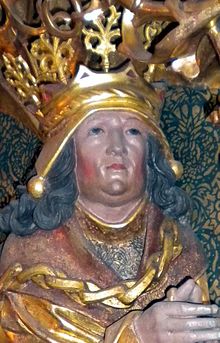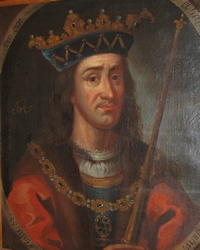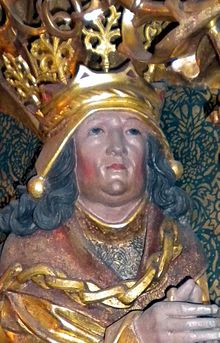Contents |
Biografi
Hans, född Johannes 2 februari 1455, son till Kristian I och Dorotea av Brandenburg, bror till Fredrik I och gift 6 september 1478 med Kristina av Sachsen (1461–1521).
Han blev vald till efterföljare till Christian I;
i Danmark i 1456, han blev kung av Danmark från 1481
i Norge og Sverige i 1458, han blev kung av Norge från 1483 och var kung i Sverige 1497–1501, där han även är känd som Johan II.
Död 20 februari 1513.
Biography
Hans was as a child elected successor to the throne in all three countries. In Denmark he became king without oppossition. In Norway the powerful church turned against his election, but had to give up and acclaim him, as he issued a document for Denmark and Norway, which extended the Council’s and the nobility’s power considerably.
This document was also ment for Sweden. The Swedish Council could not resist such an offer and elected Hans as their king. But Sten Sture understood at meetings and sub-negotiations to delay Hans, so that it took many years before he really got Sweden in his power.(...)
The nobilities were not always satisfied with king Hans, who with severity maintained his power.(...) Buried in Odense Gråbrødrekloster, later moved to St. Knuds Church in Odense. King Hans was son of Christian 1st and queen Dorothea. In 1478 married to Christine of Sachsen (1461-1521). They had the children:
Christian 2nd, 1481-1559, later king. Elisabeth, 1485-1555, marrid in 1502 to Joachim 1st of Brandenburg. Frans, 1497-1511 Hans Jacob
- John, Johann, Johan II, or colloquially "Hans", Danish monarch and union king of Denmark (1481 ñ 1513), Norway (1483 ñ 1513) Sweden (1497 ñ 1501), under the Kalmar Union, and also Duke of Schleswig and Holstein. He was born on February 2, 1455 as the son of Christian I and Dorotea av Hohenzollern-Brandenburg, daughter of Margrave Hans of Brandenburg. In 1478 he married Christina of Saxony, granddaughter of Frederick the Gentle of Saxony. This produced the following offspring: Christian II of Denmark, Franciscus, Knud, and Elisabeth, who later married as princess of Brandenburg. He died on February 20, 1513.
THE KALMAR UNION 1397-1523
The most important aspect of the Kalmar Union was the personal union between the three kingdoms of Denmark, Norway and Sweden. Also included in this fellowship was Finland, that was a part of Sweden (until 1809), and Iceland, Greenland, the Faroes and the Shetland archipelago, belonging to Norway, meaning that the union encompassed all of the Nordic countries. The formal marking of the unification took place in the Swedish city of Kalmar, where Erik of Pomerania was crowned king of all three realms in 1397. The union’s centre of power was located in Denmark, but all the countries were principally ruled according to their own laws and traditions. The union was, with short breaks, maintained from 1397 to 1448. Following this, only the personal union with Norway – with a few interruptions – remained in effect (until 1814), while the Danish kings only managed to rule in Sweden for brief periods until Sweden definitively seceded by proclaiming Gustav Vasa king of Sweden in 1523.
John, also known as Hans; né Johannes[1] (2 February 1455 – 20 February 1513) was King of Denmark (1481–1513), Norway (1483–1513) and as John II (Swedish: Johan II) of Sweden (1497–1501) in the Kalmar Union, and also Duke of Schleswig and Holstein. The three most important political goals of King John were the restoration of the Kalmar Union, reduction of the dominance of the Hanseatic League, and the building of a strong Danish royal power.
He was born at Aalborghus, in Aalborg, the son of Christian I of Denmark and Dorothea of Brandenburg, daughter of Margrave John of Brandenburg. In 1478, he married Christina of Saxony, granddaughter of Frederick the Gentle of Saxony. This produced the following offspring: Christian II, Francis, Knud, and Elisabeth, who later married as princess of Brandenburg. From about 1496 until 1512, he had a relationship with Edele Jernskjæg.
Reign [1]
Hans was as a child elected successor to the throne in all three countries. In Denmark he became king without oppossition. In Norway the powerful church turned against his election, but had to give up and acclaim him, as he issued a document for Denmark and Norway, which extended the Council’s and the nobility’s power considerably.
This document was also meant for Sweden. The Swedish Council could not resist such an offer and elected Hans as their king. But Sten Sture understood at meetings and sub-negotiations to delay Hans, so that it took many years before he really got Sweden in his power.
In the year 1497, however, the old enmity between Sten Sture and the Council broke into open fight. Then king Hans caught the opportunity, left for Sweden with a large army, and enclosed the country’s chief in Stockholm. Dalkarlene’s rescue army was defeated by the Danes at Rotebro, and when the victors returned, Sten Sture made an attack, which ended with a huge defeat for him.
Eventually he gave up and acknowledged Hans on terms, that he himself got Finland as len (county). Hans was crowned, and his son Christian acclaimed as his successor. Thus the union was renewed exactly 100 years after the crowning in Kalmar.
Three years later king Hans was defeated in Ditmarsken, and Sweden rebelled again.
The nobilities were not always satisfied with king Hans, who with severity maintained his power. To the middle class king Hans showed predilection, and had for a short time his son Christian brought up by a merchant from Copenhagen, Hans Bogbinder. All together he was popular for his Danish way of living and thinking. He was the first native born king after Valdemar Atterdag. But by his good-temper he could be random, unfair and melancholy. It it the same characteristics, but to a greater extend, which are retrieved in his son.
Buried in Odense Gråbrødrekloster, later moved to St. Knuds Church in Odense. King Hans was son of Christian 1st and queen Dorothea. In 1478 married to Christine of Sachsen (1461-1521). They had the children:
Christian 2nd, 1481-1559, later king.
Elisabeth, 1485-1555, marrid in 1502 to Joachim 1st of Brandenburg.
Frans, 1497-1511
Hans
Jacob[2]
Sources
Acknowledgements
- This person was created through the import of McQuery Family Tree.ged on 20 May 2011.
- Profile created by Travis Wagner.
It may be possible to confirm family relationships with Hans by comparing test results with other carriers of his Y-chromosome or his mother's mitochondrial DNA. Y-chromosome DNA test-takers in his direct paternal line on WikiTree:
- Nicholas II (Romanov) Романов
 :
Y-Chromosome Test 17 markers, haplogroup R-M269, MitoYDNA ID Z10007 [compare]
:
Y-Chromosome Test 17 markers, haplogroup R-M269, MitoYDNA ID Z10007 [compare]
Have you taken a DNA test? If so, login to add it. If not, see our friends at Ancestry DNA.
 Stephanie (Ledbetter) Ross
Stephanie (Ledbetter) Ross
Featured National Park champion connections: Hans is 14 degrees from Theodore Roosevelt, 19 degrees from Stephanus Johannes Paulus Kruger, 14 degrees from George Catlin, 18 degrees from Marjory Douglas, 25 degrees from Sueko Embrey, 18 degrees from George Grinnell, 19 degrees from Anton Kröller, 17 degrees from Stephen Mather, 20 degrees from Kara McKean, 19 degrees from John Muir, 9 degrees from Victoria Hanover and 27 degrees from Charles Young on our single family tree. Login to find your connection.
O > Oldenburg | O > Oldenberg > Johannes (Oldenburg) Oldenberg
Categories: Denmark Project Management Prospects | Royalty | House of Oldenburg | Sweden, Monarchs | List of Danish Monarchs | List of Norwegian Monarchs





